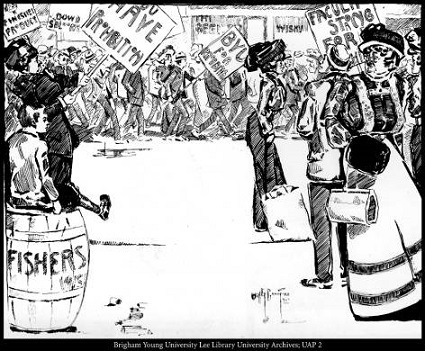Dublin Core
Title
Description
Utah’s history of anti-liquor laws began before Prohibition in the United States.
Years before the Eighteenth Amendment to the US Constitution was ratified in 1919, prohibiting the manufacture, sale, or transportation of "intoxicating liquors" within the United States, a number of Utah towns and cities already had anti-liquor laws on the books. In 1911, officials in St. George made it a crime to make or sell liquor. Grand County also had its own version of an early prohibition law.
What police officers and public officials soon discovered, however, was that the passage of anti-liquor ordinances often didn't put a dent in drinking or liquor manufacture. This trend became even more evident after the passage of the Eighteenth Amendment. In 1923, Utah's attorney general went so far as to claim that drinking in the state's largest cities was as bad as it had been before federal prohibition. It didn't help that some public officials didn't take prohibition seriously. Beaver County authorities, for instance, claimed the worst bootlegger in the city of Milford was none other than the city marshal's own sister. And when police raided underground speakeasies in Salt Lake, they often caught off-duty policemen among the illegal drinkers. In all, from 1925 to 1932, the year before Prohibition was repealed, federal agents in Utah seized 400 distilleries, 25,000 gallons of spirits, 8,000 gallons of malt liquor, and 13,000 gallons of wine.
By 1933, the Eighteenth Amendment was well on its way to being repealed, and Utah was set to be the deciding state. The LDS Church fought hard against repeal, but in the end, the voters of Utah had their way and buried Prohibition, an ironic turn of events in a state that seemed to lead the way in anti-liquor legislation.
Creator
Source
Image: Cartoon inspired by the controversy over a Provo ordinance prohibiting the sale of alcohol, 1909. This cartoon was inspired by the controversy that raged over a local Provo ordinance prohibiting the sale of liquor in 1909. On the near side of the street are the red-nosed "wets" standing among beer barrels. Across the street are the "dry" students and faculty, parading in front of a saloon carrying prohibition signs. Courtesy of Harold B. Lee Library.
_______________
See the February 1995 collection of the History Blazer, a joint project of the Utah State Historical Society and the Utah State Centennial Commission. The History Blazer can be found on the Utah History Suite CD available from the Utah State Historical Society.

